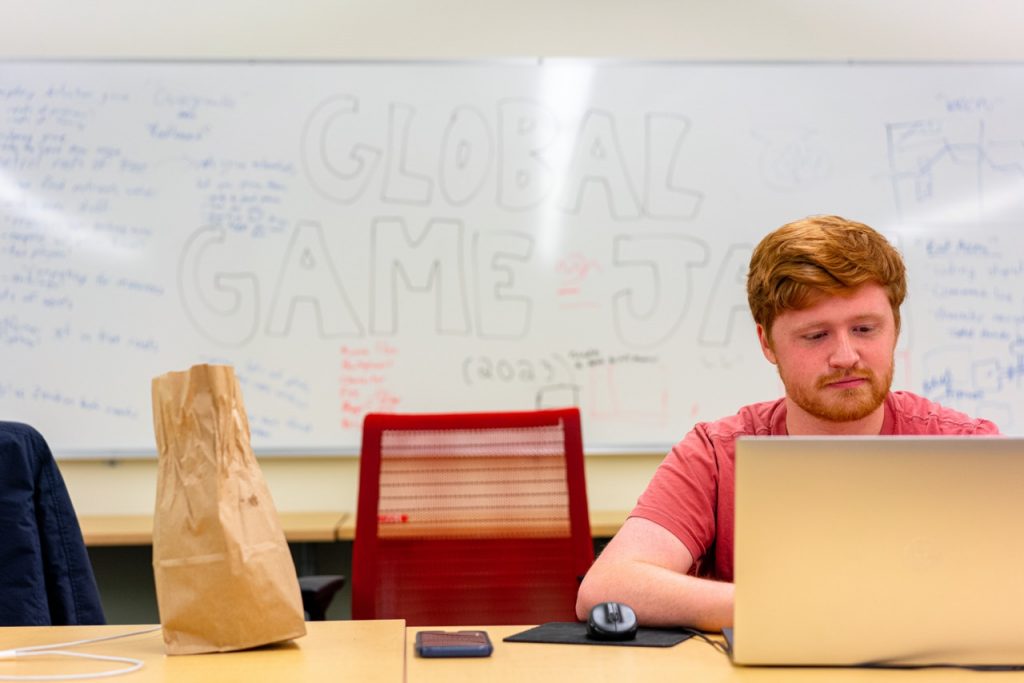Video games are complicated. Even a game as deceptively simple as Pac-Man is composed of a delicate concoction of level design, character art, artificial intelligence, and audio/video signals, all powered by lines upon lines of code. Today, the biggest games in
the industry, which draw revenue eclipsing Hollywood blockbusters, take years to develop and can involve hundreds of artists, designers, and programmers. The Last of Us took four years to make; a project as small as an iPhone game can take months. So when a group of University of Virginia students decided to make two games in just 48 hours, they were shooting for the moon.
Despite such a daunting challenge, students were relaxed as they trickled into UVA’s Rice Hall, home of the Department of Computer Science and the computer engineering program, on a chilly Friday evening. The occasion was the 2023 Global Game Jam, and it was the first that the Student Game Developers would participate in since the beginning of the COVID-19 pandemic.
A game jam can take all sorts of forms, from a massive formal competition to a creative exercise in a small office. The annual Global Game Jam, which was founded in 2008 and is managed by the nonprofit of the same name, is among the largest of its kind in the world. But no matter the size, the general idea remains the same: Game jams are about creating an entire video game in an extremely limited amount of time. It’s similar to a hackathon, or the 48 Hour Film Project held each year across the country—solo participants or teams register for the jam and are faced with a singular challenge, like a common theme, and a set deadline to submit their work.

Game jams tend to be makeshift affairs—anywhere you can plug in a laptop will do. For this year’s Global Game Jam, around a dozen UVA students gathered in a conference room with two whiteboards and a writable wall. They formed one of hundreds of sites, across more than 100 countries, with participants whose work would sit alongside thousands of others’ creations.
The Global Game Jam kicks off with the announcement of the year’s theme. This time, it was “roots.” Club president Jimmy Connors wrote the word in the center of one of the whiteboards.
How do you turn “roots” into a video game? You start, like with any creative project, by brainstorming.
So, Connors asked, what do we think of when we think of roots?
“I have no idea where to take that,” he said.
But ideas came fast from around the room: family roots, square roots, trees, plants, linguistic roots of words, root canals, hair roots, rooting for a sports team, musical roots of chords. The board filled up fast as participants played off of each other’s suggestions.
“You could do a game where you control a plant whose roots are continually growing, and you have to steer it into nutritious deposits.”
“The farther down you go, the rockier it gets and the harder it gets.”
“Well, there’s that restaurant, Roots.”
“So, trees can communicate through mycorrhizal networks, which are just root networks. So we could do some tree communication game that involves roots and networking.”
“Game that teaches you the basics of networking.”
“You control the roots of a tree and you can then discover things like fossils, like an archaeology game. You can pass by bones or discarded items.”
“A mystery deduction game where you’re trying to trace back the roots of what led to whatever event.”
“You want to guide the tree roots towards water, you want to guide them towards mineral deposits.”
“There are pollution spills that you have to steer away from.”
“And your score at the end is how deep your roots got.”
“A genealogy game?”
“The root of a computer. Think plants growing on a computer chip.”
“You have a little character that’s navigating in the computer file system, and you’re trying to get to the root of the computer so you can hack it.”
“Oh, trying to get root access!”
Connors went around the room again and again, whittling down everyone’s ideas. One by one, different roots were crossed off, until they had two promising concepts to pursue: a game about growing roots in a pot, and a game about exploring a computer as if it were a dungeon. The group would need to split up and complete both of these games by Sunday at 5pm.
But so many questions still lingered. How are they going to manage two projects? Who in the room can program? Who can create artwork, like characters and backgrounds, for the games? Who can write background music? And, most importantly, who has time to devote to the game jam? When can people drop in over the weekend to work?


Some people had homework and exams to prepare for. Others weren’t experienced in Unity, the popular game development software the club used for the jam, which meant they’d need to spend time learning it.
There was so much to deliberate over. But first: pizza. They’d begin working in earnest Saturday morning.
Day two started with a Bodo’s run, which Connors considers crucial to the success of the game jam. “Food is big and good,” he says. “As an SGD president, sometimes it’s hard to get people to show up to make games for 10 hours on a weekend. Bodo’s helped a lot with getting people in the room.”
It was heads-down work in the conference room as the two teams set about designing and coding each game. The first, titled Overgrowth, would be about carefully drawing roots in a planter as they get longer and longer. It was inspired in part by Snake, a game famous for coming pre-installed on Nokia phones, in which the player controls an ever-growing snake in a constrained space. The second game, Root Access, would be about exploring a maze-like computer system resembling a dungeon and cleaning out the viruses mucking up the place. This was inspired by another game jam game, The Binding of Isaac, which tasks players with navigating a procedurally generated series of rooms.
Oliver Mills, a third-year computer science student, worked on the textures for the roots in Overgrowth. This was his first game jam with the Student Game Developers, which he joined so he could learn to make his own game. “I’m working on a little self-project right now that reflects the weather, that has some realtime reflection of the weather in a game,” said Mills. “And I realized that I had no clue how to do anything with games.”
Fellow third-year CS student Ian Harvey is an officer in the club, and designed the computer terminal for Root Access, where players can input slash commands that trigger various effects. “We’re basing it around the idea of what is a computer’s structure, what the traversal may be in a theoretical world where you’re trying to get to the root of the computer,” said Harvey. A challenge his team faced was in filling the game with things to interact with. “It comes down to assets, or actually making a dungeon that feels like it’s fun to traverse. Assets are one thing, being able to [code] a bunch of enemies to do specific things.”
Harvey is a seasoned game dev for an undergraduate, having directed a game in the club and worked on many others. Though he’s participated in other game jams, this is his first with the Student Game Developers. “I typically do one game jam a year in the summer,” he said. “I never do well in it, but it’s always fun to just spend the weekend losing all my sleep and making whatever I can.”
Catherine Xu, a second-year CS major, joined the event as her first game jam. On Root Access, her focus was on character movement and designing “mobs,” or mobile objects, like enemies. Some of the programming already existed for these elements; her job was then to assign them animations.
“The challenging part is trying to balance where we want the player to explore, but then also the necessary set path of actions they need to take to unlock the rooms [and] get to the destination,” said Xu. “So, we want it to be somewhat challenging, we want them to have fun exploring, but we also don’t want it to be too easy to figure out how to open doors and passwords and stuff.”
The final projects, available to play on the Global Game Jam website, reflect the project management skills, prioritization, and quick thinking of both teams.
In the finished version of Overgrowth, the player is presented with a cross-section of a houseplant as it first starts to take root. The player’s job is to click and drag the snaking roots to fill the limited space in the pot. Once each root reaches its maximum length, two more roots will sprout from it, which can also be dragged and drawn out to fill the pot. A bar rises on the right side of the screen to track the player’s progress, and at specific intervals the plant will be repotted and a new larger level will begin.
Root Access took shape as an action game, where the player navigates a virus-riddled computer as if it were a treacherous dungeon. Using the WASD keys to move from folder to folder, the player needs to eliminate bugs—represented as flies and spiders—from files. A computer terminal can be brought up with the forward slash key, where the player can input various commands that allow them to teleport to different locations or switch weapons.
Both feature all sorts of sensory flourishes, from the colorful hand-drawn aesthetic of a growing plant in a sunny greenhouse to the gritty pixel art representing an infected computer. Pensive music accompanies the leisurely atmosphere of Overgrowth, while pounding techno thumps behind the intense gameplay of Root Access.
As president, Connors was most concerned with making sure the Global Game Jam was a fun and worthwhile event for everyone involved. But, personally, he was nervous about how developing a game as a team would play out. He’d only ever jammed by himself. How would splitting up roles work? Would the files all break each other if they were separated between different computers?
To his surprise, everything worked out fine.
“Definitely both [games] were constrained,” says Connors, who will graduate this spring. “I think that’s basically always true for game jams. You always have to cut half the stuff you thought of. … But that’s kinda how game jams are. It’s all about doing stuff quick, learning a bunch, and working with other people, doing cool things.”
You can play Overgrowth at globalgamejam.org/2023/games/overgrowth-3 and Root Access at globalgamejam.org/2023/games/root-access-4-1.
